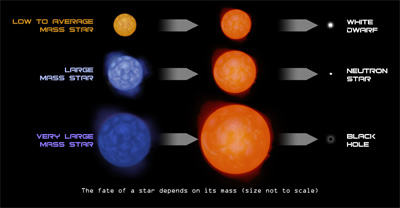The Milky Way Galaxy contains several hundred billion stars of all ages, sizes and masses. One of the central quests of astronomy is to understand how these star form, shine for billions of years, and eventually fade quietly into the dark as white dwarf, or go out with a bang as supernovas.
Chandra and other X-ray telescopes focus on the high-energy action of this drama - sudden outbursts on the turbulent surfaces of stars, gale-force outflows of gas from hot, luminous stars, and awesome shock waves generated by supernova explosions.
A Star is BornA star is born when a cloud of gas and dust collapses to the point where the material in the center of the clump is so dense and hot that the nuclear fusion of hydrogen nuclei into helium nuclei can occur. The outflow of energy released by these reactions provides the pressure necessary to halt the collapse. Note that the nuclear reactions inside stars are nuclear fusion reactions in which the nuclei of light elements are fused together to form heavier elements (for example hydrogen nuclei are combined to form a helium nucleus) with the release of energy. In contrast, power plants on Earth produce energy through nuclear fission, in which the nuclei of heavier elements such as uranium are split apart to form smaller nuclei with the release of energy.
Hydrogen Burning Core (Main Sequence)
Fusion of hydrogen into helium in the core of star can sustain a star such as the Sun for billions of years. The Sun is now in this long-lived phase of its evolution, called the main-sequence phase.
Red Giants.When the hydrogen in the star's core is used up, the energy flow from the core of the star stops, the central regions of the star will slowly collapse and heat up. Nuclear reactions in a shell of gas outside the core will provide a new source of energy, and cause the aging star to expand outward in the "red giant" phase.
Mass Matters.If the star is about the same mass as the Sun, it will turn into a white dwarf star. If it is somewhat more massive, it may undergo a supernova explosion and leave behind a neutron star. But if the collapsing core of the star is very great-at least three times the mass of the Sun-nothing can stop the collapse. The central part of the star - the entire star if the star is massive enough - implodes to form an infinite gravitational warp in space called a black hole.
The brightest X-ray sources in our galaxy are the remnants of massive stars that have undergone a catastrophic collapse-neutron stars and black holes. Other powerful sources of X-rays are supernova remnants - giant bubbles of hot gas produced by exploding stars. White dwarf stars and the hot, rarified outer layers, or coronas, of normal stars are less intense X-ray sources.
This tableau illustrates the ongoing drama of stellar evolution, and how the rate of evolution and the ultimate fate of a star depends on its mass.
Stars are formed in giant clouds of dust and gas, and progress through their normal life as balls of gas heated by thermonuclear reactions in their cores. Depending on their mass, they reach the end of their evolution as a white dwarf, neutron star or black hole. The cycle begins anew as an expanding supershell from one or more supernovas trigger the formation of a new generation of stars. Brown dwarfs have a mass of only a few percent of that of the Sun and cannot sustain nuclear reactions, so they never evolve.






